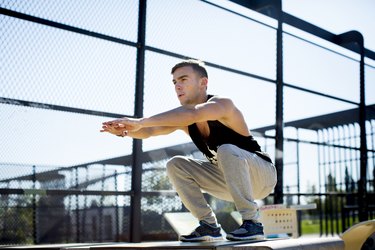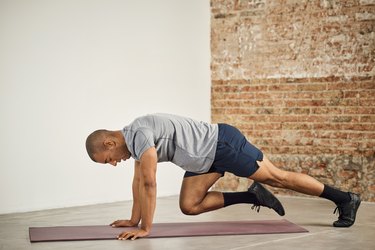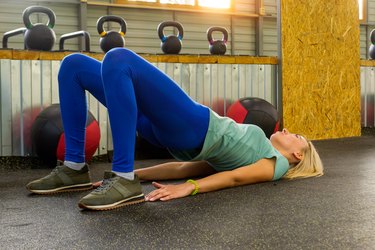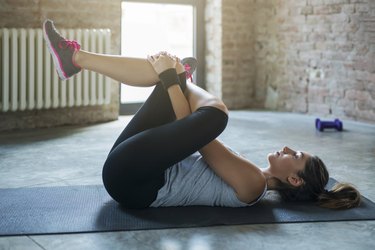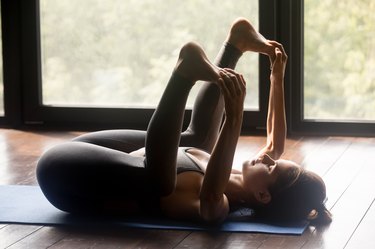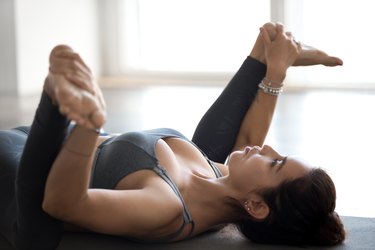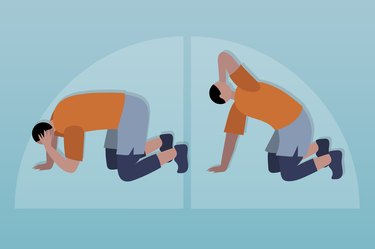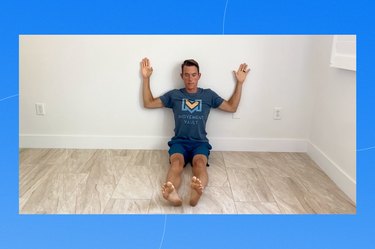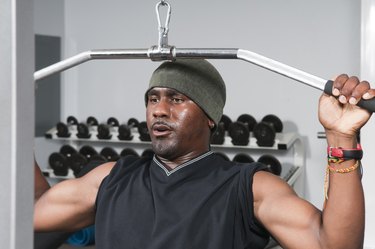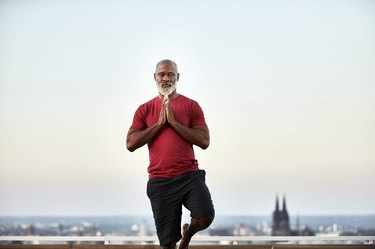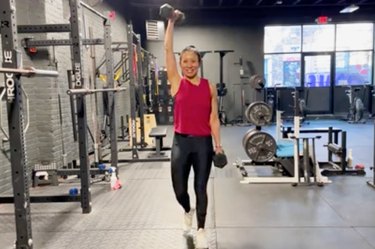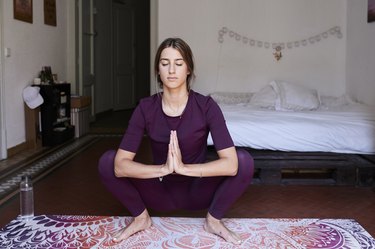
Many yoga classes include the yoga squat (or "malasana" in sanskrit), but lots of people don't feel comfortable getting into it. If you can't do a yoga squat, your body might have limited mobility or weakness in one of the many areas this posture works — and those are things you can improve.
To do a yoga squat, you begin by standing with your feet a bit wider than hips-width distance apart and your toes pointing outward. With your palms together in a prayer position in front of your chest, you slowly lower your hips down toward the ground, keeping your chest lifted and eyes gazing straight ahead.
Video of the Day
How to Get Into a Yoga Squat
- Stand with your feet slightly wider than hip-width apart, with your toes slightly turned out.
- Bend your knees and come down into a full squat with your butt as close to the ground as your mobility allows.
- Once you're in your full squat, take the time to adjust your feet and stance as needed. Try to keep your heels flat on the ground, but it's OK if they come up slightly.
- Keep your torso straight as you bring your palms together and press your elbows into your knees to draw your legs apart.
- Keep your gaze forward, shoulders back and focus on lengthening through your spine.
- Think about reaching your tailbone toward your heels.
- Hold for 30 to 60 seconds.
While it may look fairly simple, this deep posture requires flexibility in your feet, ankles, knees, hips and even your upper body.
If you find it difficult to get into a yoga squat, don't let it deter you from signing up for a class or doing an at-home flow. You can still get all the benefits of the yoga squat with modifications that support your body where it is right now.
If Your: Heels Come Off the Ground
You Might: Need to Work on Your Ankle or Calf Mobility
If you try to sink down into a full malasana and your heels lift off the ground, the culprit is likely tightness in your achilles tendons (the long muscles that run from your ankles up the backs of your lower legs) and/or calf muscles, which are being stretched in this pose.
An ankle mobility workout, including calf massage on a foam roller and strengthening moves like the squat with elevated heels, can help you work your way up to a full yoga squat. With a 10-minute session a few times a week, you'll start to see a noticeable improvement (if you've had injuries or surgeries, just make sure to talk to your doctor before starting a new exercise routine).
Before attempting a yoga squat, you can also warm up by stretching the backs of your ankles and lower legs with yoga poses like supine head-to-knee pose (with or without a strap around the foot) or seated head-to-knee pose.
Head-to-Knee Pose
- Begin seated with your legs out wide. Bend your right knee and bring your right foot in toward your groin.
- Inhale and stretch the crown of your head up toward the ceiling as you gently press your tailbone down to lengthen your entire spine.
- Turn to face your left leg, maybe pressing your fingertips into the ground to create even more length.
- On your exhale, lower your chest down as far as it will go. Use your hands to grab hold of your leg, ankle or foot for an added gentle stretch.
- Breathe deeply into the stretch for 5 to 10 full breath cycles. On your inhales, think about breathing space into your outer hips, hamstring and spine. On your exhales, see if you can reach your chest further forward (not down) toward your foot.
- Gently return to your starting position by lifting your chest, stretching your right leg out so you’re back in your wide-legged stance.
- Take a few breaths, then perform on the other side.
In these postures, be sure to flex your foot and draw your toes back toward your face to encourage the backs of your legs to stretch. The most important part, as with any yoga pose, is to breathe deeply into the stretch.
The amount of time it takes to achieve a full yoga squat will vary from person to person, and depend on things like your current mobility and daily activities. If you're having difficulty with your mobility, you may want to consider working with a physical therapist.
If Your: Lower Back Arches Excessively
You Might: Have Tight Hip Flexors
Maintaining a neutral spine is important when you're performing squats, even in yoga. Over-arching your lower back can compress the vertebrae and lead to pain and injury over time.
If you notice that your lower back is arching a lot when you're lowering into your squat, it's probably because your hip flexors are tight. Your hip flexors may be tight because of things like poor posture or weak core muscles.
To work on it, practice strengthening your deep core stabilizer muscles with exercises like the glute bridge. This move will also help stretch your hip flexors.
At the same time, you can work on lengthening those tight hip flexors with yoga poses like supine pigeon (or figure four) pose, happy baby pose and reclined cobbler's pose.
It's also a good idea to be mindful of your posture throughout the day and, if possible, avoid sitting for long periods of time, which can shorten your hip flexors and cause compression in your lower back.
If Your: Spine Rounds Forward
You May: Need to Work on Thoracic Spine or Hamstring Mobility
To properly perform a yoga squat, your chest should remain lifted with your sternum facing up toward the ceiling. But if you find that your upper body is rounding forward when you come down, it's likely that your upper back (aka your thoracic spine) or your hamstrings are tight.
Tightness in the upper back is common and mostly comes from poor posture. You can loosen up the muscles in your middle and upper back with spinal twists performed standing or laying on the ground. Stretches like the t-spine rotation can help, too.
And while the connection might not seem obvious, your hamstrings play a big role in how your spine moves. The hamstrings are connected to muscles in your pelvis, and when those become restricted, the mobility in your spine is affected. This can lead to compression in your back, which may cause your spine to round forward.
Before you try getting into a yoga squat, postures like downward facing dog, standing forward fold and supine head-to-knee pose can help loosen things up.
And again, it's a good idea to mind your posture throughout the day by standing up straight and drawing your shoulders down and back to help you avoid hunching as much as possible.
If You: Lean More to One Side
You May: Need to Work on Your Stability
If you find that you're putting most of your weight on one side as you get into a yoga squat, you probably need to work on creating more stability in your body. This may be because one side is tighter than the other or because one side is weaker than the other.
Standing yoga poses, like tree pose and the warrior poses (I, II, and III), are great for strength, stability and balance.
If you're less flexible on one side of your body (for example, if you're right-side dominant, your right side may feel tighter than your left), it may be useful to practice unilateral yoga poses like the single-leg bridge or box lunge to help even things out.
Leaning more on one side is also common if you've had an injury or surgery on one side of your body, as it could be your body's defense against further injury or pain. Always talk to your doctor before doing any type of exercise to be sure it's safe for you, and never do a yoga pose if it causes pain.
If Your: Knees Ache
You Might: Need to Check Foot Placement, or Work on Strengthening Knees
It's important to note that you should never feel pain in any yoga pose. People with knee injuries or recent surgeries shouldn't practice the yoga squat. If you've had any in the past, be sure to check with your doctor before attempting this posture.
That said, a dull ache in the knees during malasana may indicate that you need to check in with your feet. The stability of your knees begins in your feet, and if the arches of your feet are falling inward, your knees may be rotating too much.
Always make sure that your arches are lifted in a yoga squat, and that you're pressing into the balls of your feet and your heels to keep your foot muscles engaged. If this feels difficult, support the bottoms of your feet with a rolled up towel or blanket (see modifications below).
Aching knees may also be a sign that your knee joints (or the muscles around them) need strengthening. Try any of these exercises that are designed to build up strength around the knee.
Modifications for the Yoga Squat
1. Use a Towel or Blanket Under the Heels
The easiest and most common modification for the yoga squat is to support yourself with a rolled up blanket or towel underneath your heels. This brings the floor closer to you, which allows your feet, legs and hips to relax and your spine to lengthen in the pose.
2. Take a Wider Stance
If your heels are coming really close to the ground but aren't quite reaching, taking a wider stance with your feet and turning your toes out a bit more might do the trick in getting the heels down.
That said, you'll want to make sure the arches of your feet remain lifted (i.e. they're not sinking in toward the middle) while in the pose. Sinking arches can lead to knee issues down the line.
3. Keep the Hips Lifted
If you're feeling discomfort in your knees, modify the pose by keeping your hips higher than the knees (i.e. not coming all the way down to the ground). You can even hover over a chair — just be sure to keep your chest lifted and your spine neutral (this is a great modification for pregnancy, too).
4. Experiment With Your Stance
It's important to note that everyone has a different hip structure, so play around with your stance in malasana.
Experiment with the placement of your feet and toes to find the position that's most comfortable and accessible for you. As long as your arches aren't falling inward and your knees and your knees are somewhat aligned with your ankles, you can modify the pose so it works for you.
